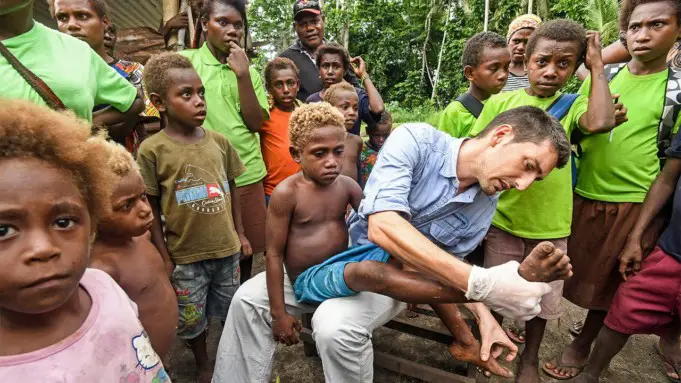Yaws is an infection prevalent in the tropical regions of the world. It is caused by the bacterium, Treponema pallidum pertenue, and affects the skin, bones, and joints.
The disease is characterized by a round, knobbly swelling on the skin which may break in the center to form an ulcer.
The first symptoms of the infection typically heal in about three to six months; however, the joints and bones may become painful weeks to a year later, and new lesions may appear.
The skin of the palms of the hands and soles of the feet may thicken and break open. Yaws may also cause the bones, especially those of the nose, to become misshapen.
The infection is transmitted via direct contact from the sores of an infected person. The disease is prevalent among children who spread it while at play. Diagnosis of the infection is by the appearance of lesions.
Testing for antibodies against the condition is not useful as it is often difficult to distinguish between current and previous infections.
It would be necessary to implement a mass treatment scheme for the entire community to decrease the risk of transmission. Also, improved cleanliness and sanitation would be effective in getting rid of the disease. Medication is typically with the use of antibiotics.
Yaws is a bacterial infection commonly found in low-income settlements in warm, humid, and tropical regions of Asia, Africa, Latin American, and the pacific. Most of the affected people are children who have no access to healthcare services.
Poor personal hygiene, poverty, and low socio-economic conditions help accelerate the rate at which the disease spreads.
According to the World Health Organization (WHO), about 75-80% of the people infected with yaws are children under the age of 15. Males and females are equally affected with lesions mostly occurring on the limbs.
The incubation period for the infection is between 9-90 days. The treatment can lead to disfigurement and disability if not treated.
Causes and Risk Factors of Yaws
Yaws is caused by Treponema pertenue, a spiral-shaped bacteria. It is considered to be a subspecies of T. pallidum, the bacteria that causes the sexually transmitted disease, syphilis.
It is also said to be closely related to another strain of the same bacteria T. carateum, which causes pinta, a skin infection with bluish-black spots.
Nonsexual contact with an infected person may increase the risk of getting infected. This is especially common in communities where the disease is endemic.
The bacteria can only infect humans if there is a cut or abrasion of the skin. Poor hygiene and crowded living conditions also increase the risk of infection.
Signs and Symptoms of Yaws
Once the bacteria infect the cut or abrasion, a small painless lesion or bump appears at the entrance site and begins to grow within two to eight weeks.
This first lesion is commonly referred to as the mother yaw. The lymph nodes in the affected area become swollen. A light-colored scar remains when the mother yaw heals.
Sometimes, nearby daughter yaws may also begin to appear along with the mother yaw. The primary stage of the infection typically resolves itself within six months.
The secondary stage of the disease occurs months to years later. In these stages, extensive skin lesions may begin to appear, and these vary in appearance.
The palms of the hands and soles of the feet become riddled with sores, a condition known as crab yaws. These secondary lesions frequently develop into ulcers and can be very infectious.
They, however, heal within six months or more.
Diagnosis
Laboratory tests like rapid plasma reagin (RPR) can be used to diagnose Treponemal infections.
It can’t, however, differentiate between yaws from syphilis. Also, although field tests can be used to diagnose the disease, they cannot tell the difference between past and current infections.
It was not until recently when dual treponemal and nontreponemal rapid tests became available that tests were able to detect both past and present infections.
Another method of diagnosis is with the use of polymerase chain reaction (PCR) technology. This is used to confirm the yaws bacteria in the DNA of the skin lesions. It can also be used to monitor the body’s resistance to Azithromycin.
The application of this technology is useful in the eradication of yaws to detect the few cases left after the community has undergone mass treatment.
Treatment
The World Health Organization recommends either of the antibiotics azithromycin or benzathine penicillin for the treatment of yaws.
- A single oral dose of Azithromycin at 30 mg/kg (maximum 2 g) is the recommended treatment
- A single intramuscular dose benzathine penicillin at 0.6 million units for children aged under ten years and 1.2 million units for people aged over ten years can be used for patients that cannot be treated with Azithromycin.












